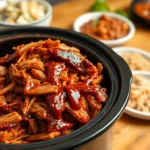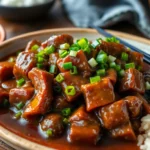We’ve all been there – craving that perfect Chinese takeout flavor but wanting something healthier and more budget-friendly. Our Chinese Beef and Broccoli recipe delivers all the savory goodness you love without the hefty price tag or mystery ingredients.
This classic stir-fry originated in Chinese-American restaurants during the 1950s and quickly became a weeknight dinner staple across America. The magic lies in the velvety sauce that coats tender beef strips and crisp broccoli florets, creating that restaurant-quality taste we’re all chasing.
What makes our version special? We’ll show you the secret to achieving that glossy, restaurant-style sauce and perfectly tender beef that rivals your favorite takeout spot. In just 20 minutes, you’ll have a nutritious, satisfying meal that’s packed with protein and vegetables – proving that homemade truly beats delivery every time.
Ingredients
We carefully select each ingredient to ensure our Chinese beef and broccoli delivers authentic flavors with tender meat and crisp vegetables. These simple pantry staples transform into an extraordinary dish that rivals your favorite restaurant.
For the Beef Marinade
- 1 pound flank steak, sliced thin against the grain
- 2 tablespoons soy sauce
- 1 tablespoon cornstarch
- 1 teaspoon sesame oil
- 1/2 teaspoon black pepper
- 1 clove garlic, minced
For the Sauce
- 1/4 cup low-sodium soy sauce
- 2 tablespoons oyster sauce
- 1 tablespoon cornstarch
- 1 teaspoon brown sugar
- 1/2 teaspoon sesame oil
- 1/4 cup beef broth or water
- 1 teaspoon fresh ginger, grated
- 2 cloves garlic, minced
For the Stir-Fry
- 4 cups fresh broccoli florets
- 3 tablespoons vegetable oil, divided
- 1 medium onion, sliced thin
- 2 green onions, chopped
- 1 teaspoon sesame seeds for garnish
- Cooked jasmine rice for serving
Equipment Needed
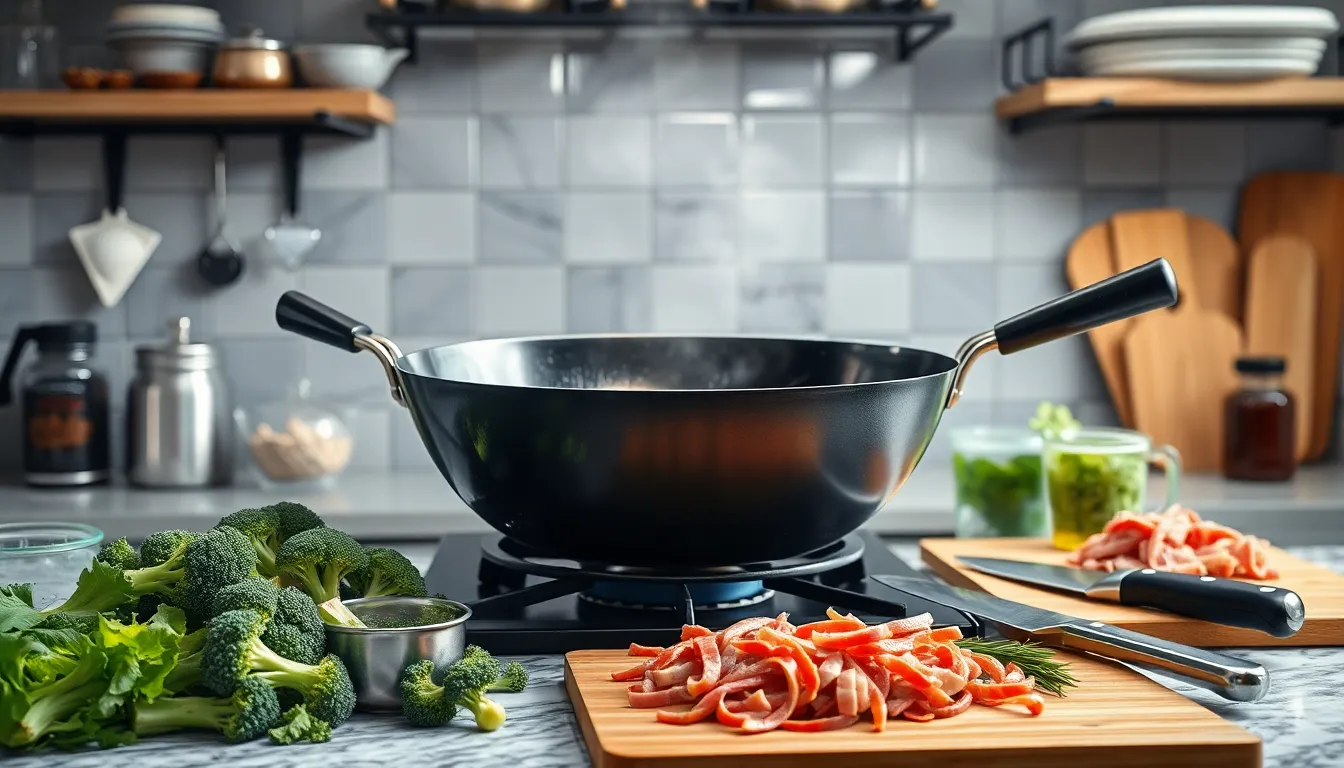
Creating restaurant-quality Chinese beef and broccoli at home requires the right tools to achieve that perfect stir-fry texture and glossy sauce we all crave. A wok stands as the traditional choice for this dish, though a large skillet works exceptionally well for home cooks who don’t own this specialized pan.
Essential Cooking Vessels:
- Wok or large skillet for high-heat stir-frying
- Mixing bowls for marinating beef and preparing sauce
- Small plate or bowl to temporarily hold cooked broccoli
Preparation Tools:
- Sharp knife for slicing beef thinly against the grain
- Cutting board with enough space for ingredient prep
- Measuring spoons and cups for accurate sauce ratios
Cooking Utensils:
- Spatula or wooden spoon for constant stirring and tossing
- Whisk for combining marinade and sauce ingredients smoothly
The wok’s high, sloped sides allow us to toss ingredients efficiently while maintaining the intense heat necessary for proper stir-frying. Our mixing bowls serve dual purposes: one for the beef marinade that tenderizes the meat, and another for whisking together the complex sauce that creates the dish’s signature glossy coating.
Sharp knives prove crucial when slicing flank steak against the grain, ensuring each piece remains tender rather than chewy. Measuring tools guarantee we achieve the perfect balance of soy sauce, oyster sauce, and seasonings that make this dish irresistible.
Having all equipment ready before we begin cooking ensures smooth execution, as stir-frying happens quickly and requires constant attention once we start.
Prep Work
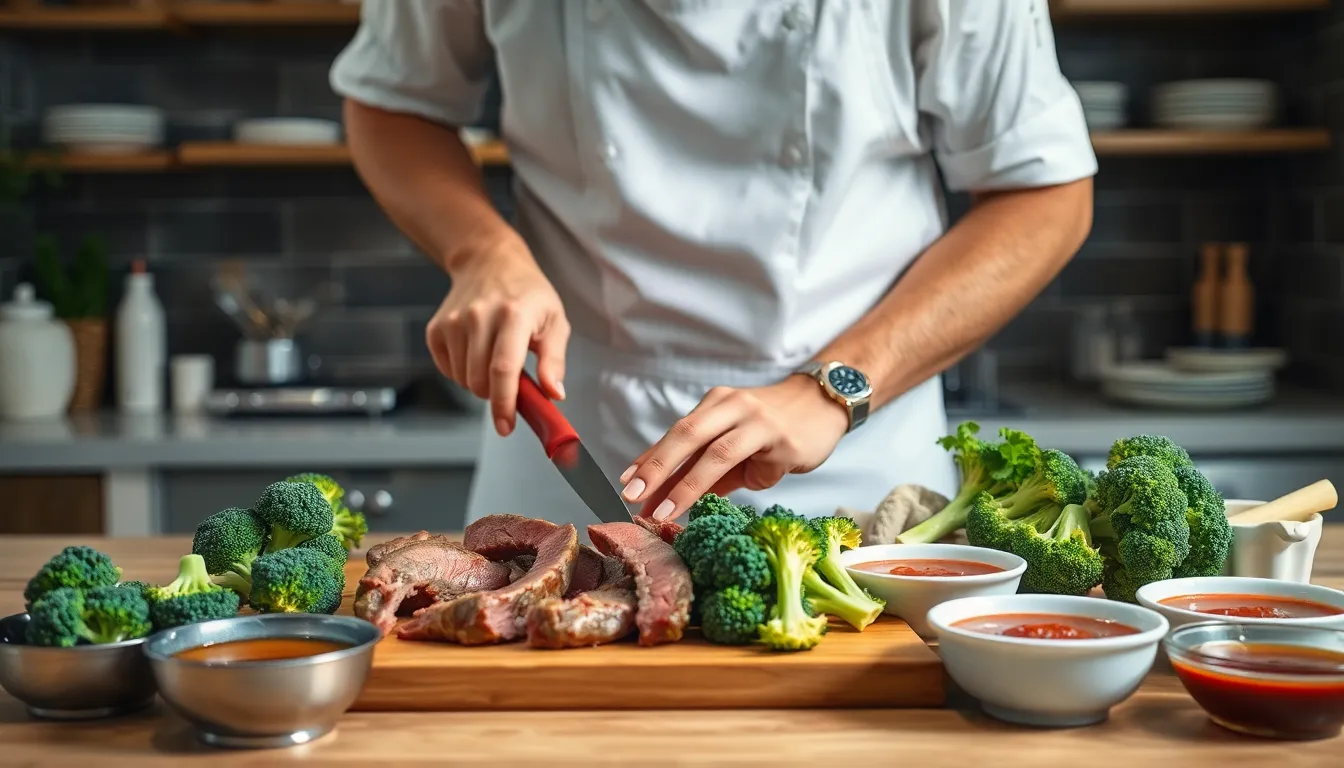
We need to prepare our ingredients systematically before cooking begins. The key to authentic Chinese beef and broccoli lies in proper preparation that ensures tender meat and crisp vegetables.
Preparing the Beef
We start by cutting our beef into thin strips against the grain, approximately 1/4 to 1/2 inch thick. This technique breaks down the muscle fibers and creates the tender texture that makes restaurant-style beef so appealing.
Next, we marinate the beef to enhance both flavor and tenderness. We combine the sliced beef with cornstarch, soy sauce, and oil in a mixing bowl. The cornstarch coating helps create that signature velvety texture while the soy sauce adds depth of flavor. We gently mix the beef to ensure every piece gets coated evenly.
We let the beef marinate for about 10 minutes while we prepare the other ingredients. This timing allows the flavors to penetrate the meat without over-marinating. For tougher cuts of beef, we can use the velveting technique by briefly blanching the marinated beef in water or oil for extra tenderness.
Preparing the Broccoli
We cut our fresh broccoli into bite-sized florets for even cooking and easy eating. Uniform pieces ensure that every floret cooks at the same rate and maintains the perfect crisp-tender texture.
Our next step involves blanching the broccoli to achieve that bright green color and ideal texture. We bring a pot of water to a rolling boil and blanch the broccoli florets for 30 to 60 seconds. Alternatively, we can steam the broccoli in a skillet with a small amount of water for about 1 minute.
After blanching or steaming, we immediately drain the broccoli and ensure it’s completely free of excess water. Excess moisture can create steam during stir-frying and prevent proper browning. We set the prepared broccoli aside until we’re ready to combine all ingredients.
Making the Sauce
We prepare our sauce by combining all liquid ingredients in a bowl before cooking begins. Our sauce mixture includes cornstarch, water, sugar, light and dark soy sauce, oyster sauce, and cooking wine like Shaoxing. We can also add optional ingredients such as sesame oil and Chinese five spice powder for extra depth.
We whisk the sauce ingredients until the mixture becomes completely smooth and the cornstarch dissolves fully. Any lumps in the cornstarch can create an uneven texture in our finished dish. The sauce should have a consistent liquid consistency at this stage.
When we’re ready to finish the dish, we stir the sauce mixture again to redistribute the cornstarch before adding it to our hot pan. The sauce will thicken quickly once it hits the heat, creating that glossy coating that makes Chinese beef and broccoli so appealing. We cook the sauce for about 1 minute until it reaches the perfect consistency.
Instructions
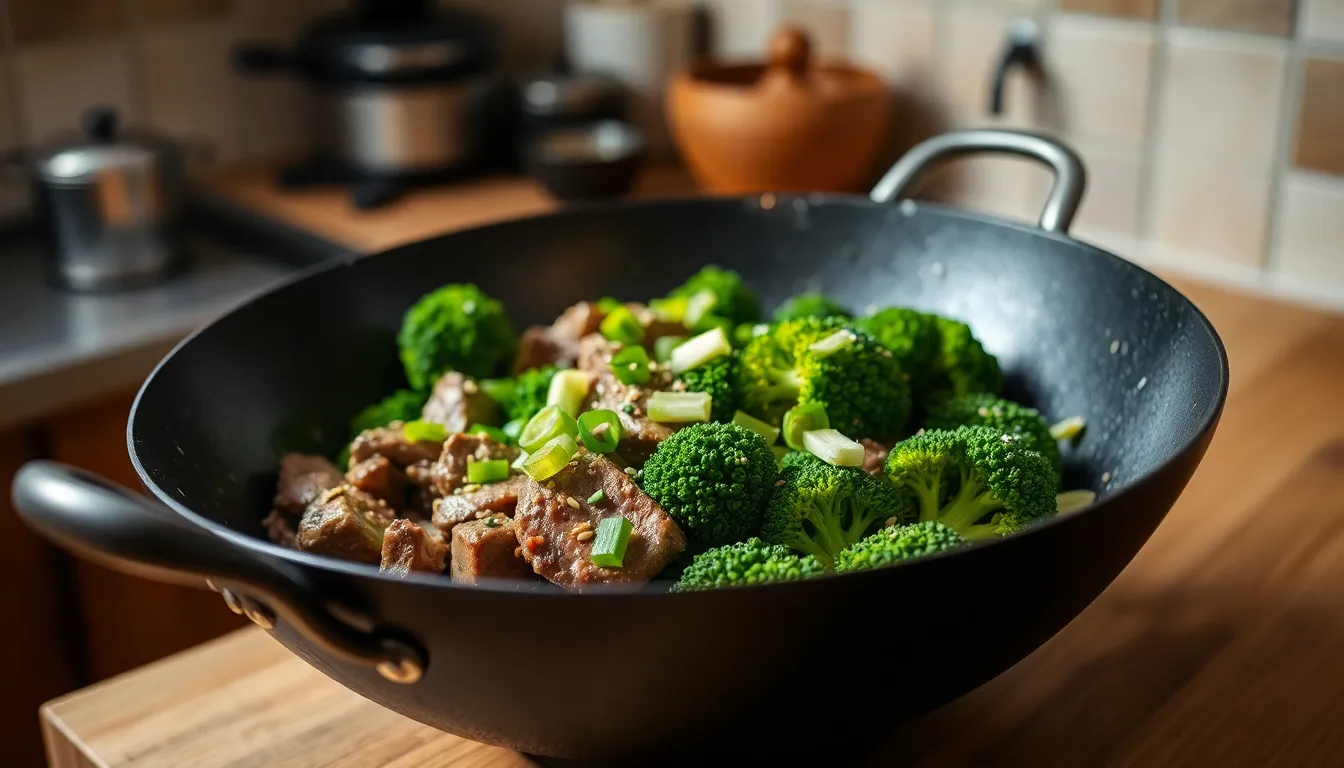
We’ll walk through each step to create this restaurant-quality Chinese beef and broccoli at home. The key to success lies in proper timing and high-heat cooking techniques.
Marinating the Beef
We start by slicing our flank steak thinly against the grain into 1/4 inch thick pieces. This cutting technique ensures maximum tenderness in every bite. Place the beef slices in a mixing bowl and add the soy sauce, cornstarch, sesame oil, black pepper, and minced garlic from our marinade ingredients.
Mix the beef gently with your hands or a spoon until every piece is evenly coated with the marinade. Allow the meat to marinate for exactly 10 minutes while we prepare the other components. This brief marinating time creates the signature velvety texture that makes restaurant-style beef so tender.
Blanching the Broccoli
We cut our fresh broccoli into uniform bite-sized florets for even cooking. Heat about 1/4 cup of water in our wok or large skillet over medium-high heat until it reaches a rolling boil.
Add the broccoli florets to the boiling water and immediately cover the pan. Steam the broccoli for just 1 minute until it turns bright green and becomes crisp-tender. We want to preserve that vibrant color and slight crunch that defines perfect stir-fried vegetables.
Remove the broccoli to a clean plate and completely wipe the pan dry with paper towels. This step prevents steaming during the beef cooking phase and ensures proper searing.
Cooking the Beef
We heat 2 tablespoons of vegetable oil in our dried wok over medium-high to high heat until the oil shimmers and becomes very hot. Add the marinated beef in a single layer without overcrowding the pan. Let the beef sear undisturbed for 30 seconds until the bottom develops a beautiful brown crust.
Flip each piece and continue cooking briefly until the beef achieves a light char while remaining slightly pink inside. This technique preserves the meat’s tenderness. Add our minced ginger and garlic to the pan and stir-fry for another 15 seconds until fragrant.
Combining Everything Together
We return the blanched broccoli to the wok with our seared beef. Pour the prepared sauce mixture over the beef and broccoli, making sure to stir the sauce first to redistribute any settled cornstarch.
Stir everything constantly with our spatula for about 1 minute until the sauce thickens and creates a glossy coating on both the beef and broccoli. The cornstarch will activate quickly in the hot pan, transforming into that signature restaurant-style glaze.
Transfer the finished dish immediately to our serving platter and garnish with sliced green onions and sesame seeds. Serve hot alongside steamed jasmine rice for the complete Chinese takeout experience.
Serving Suggestions
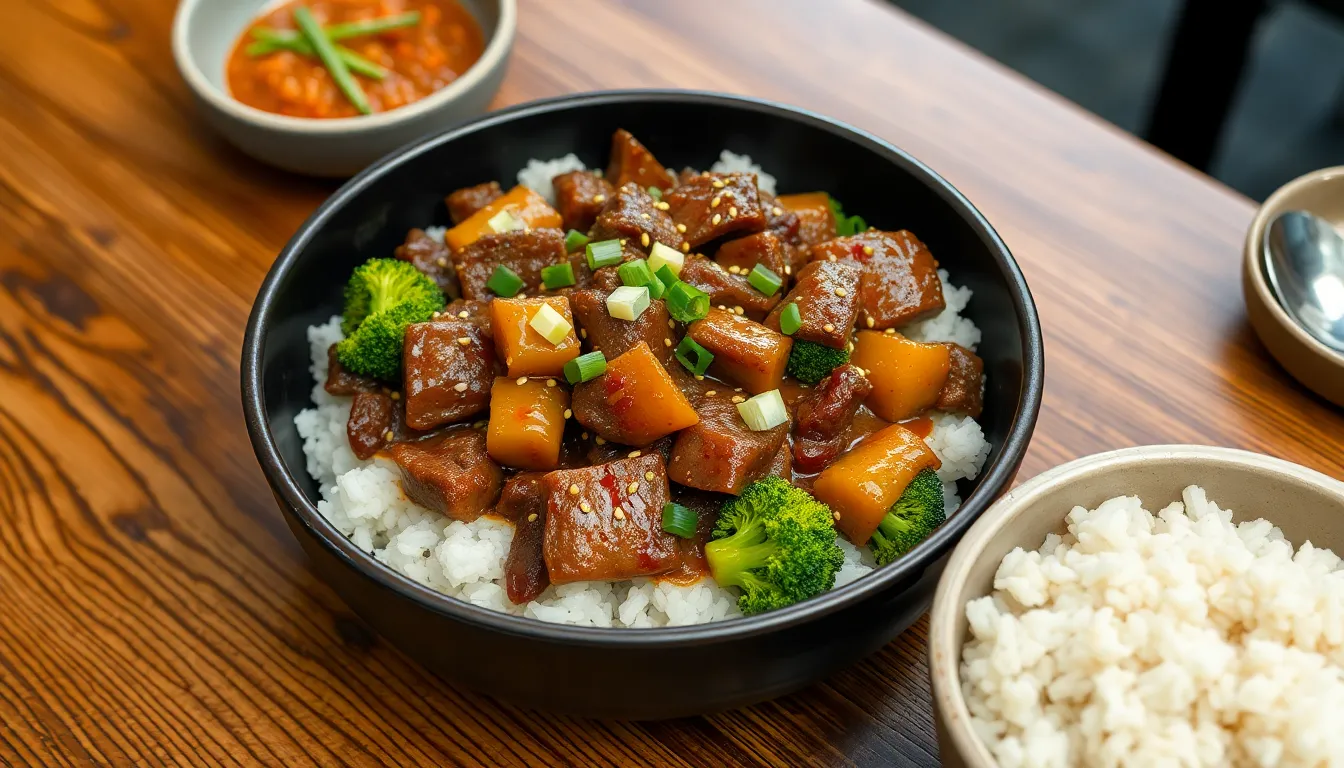
We recommend serving our Chinese beef and broccoli immediately while the sauce retains its glossy finish and the dish maintains its optimal temperature. Hot jasmine rice creates the perfect foundation for this flavorful stir-fry, allowing the savory sauce to soak into each grain and complement the tender beef and crisp broccoli.
Steamed white rice offers another excellent pairing option that absorbs the rich sauce beautifully. We suggest preparing the rice beforehand so it’s ready when our stir-fry reaches completion. Fried rice transforms this meal into an even more substantial dinner, creating layers of complementary flavors and textures.
Fresh garnishes elevate both the visual appeal and taste profile of our finished dish. Sesame seeds provide a nutty crunch that contrasts perfectly with the tender vegetables and meat. Green onions add a mild onion flavor and bright color that makes the presentation restaurant-worthy.
| Garnish Option | Flavor Profile | Visual Impact |
|---|---|---|
| Sesame seeds | Nutty, toasted | Textural contrast |
| Sliced green onions | Fresh, mild onion | Bright color accent |
| Red pepper flakes | Spicy heat | Vibrant red specks |
Heat enthusiasts can incorporate red pepper flakes for an extra kick that balances the sweet and savory sauce components. We sprinkle these sparingly since the oyster sauce and soy sauce already provide robust flavors that shouldn’t be overwhelmed.
Portion control becomes effortless when we serve this dish family-style from a large serving bowl or platter. Individual portions work well for meal prep, with each serving providing approximately 4 to 6 servings depending on appetite and accompanying sides.
The complete meal experience emerges when we present our beef and broccoli alongside other Chinese-inspired dishes. Egg rolls or pot stickers create an appetizer course, while hot and sour soup adds another dimension to the dining experience.
Storage and Reheating Tips
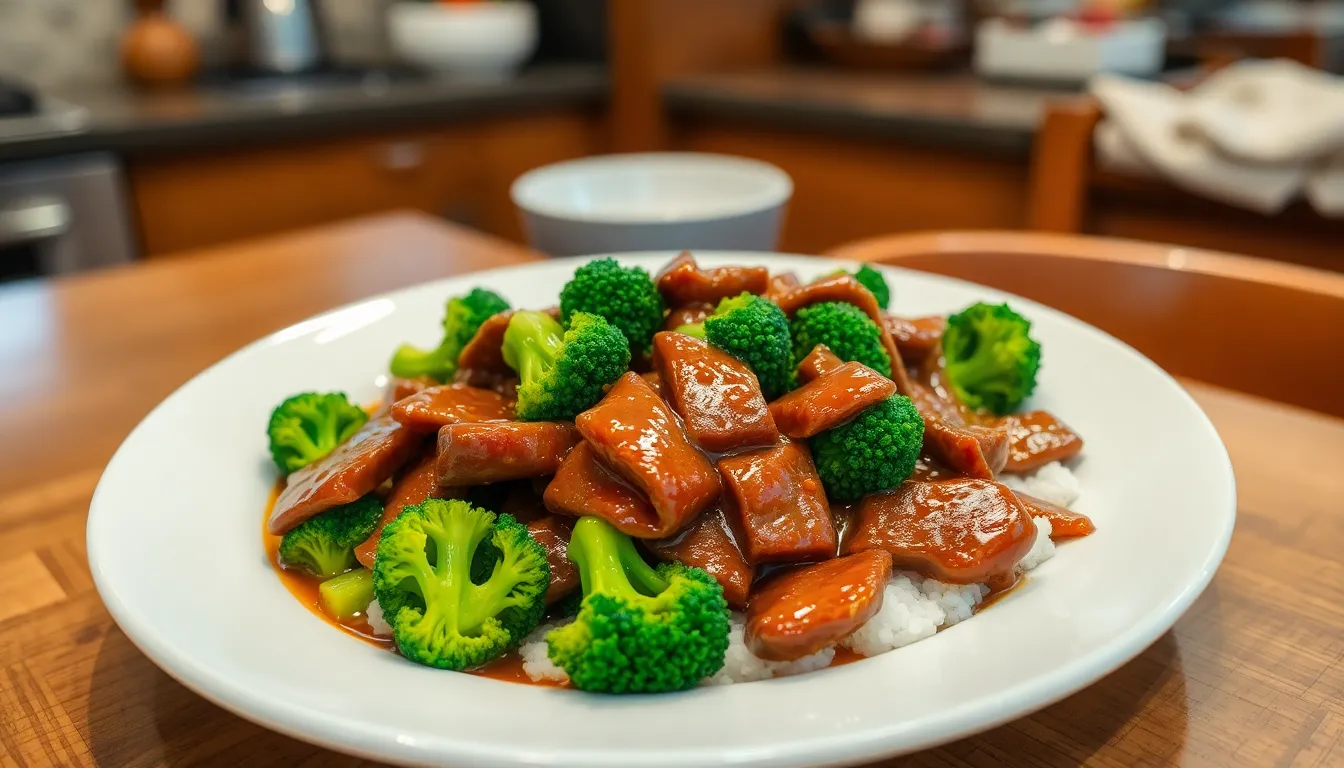
After enjoying our homemade Chinese beef and broccoli masterpiece we need to handle any leftovers properly to maintain that restaurant-quality taste and texture. Storage and reheating require exact techniques to preserve the dish’s signature glossy sauce and crisp-tender vegetables.
Proper Storage Guidelines
We should refrigerate leftovers within 2 hours of cooking to prevent bacterial growth. Store the beef and broccoli in an airtight container at or below 40°F (4°C) to maintain freshness and prevent the dish from absorbing other flavors from the refrigerator.
| Storage Method | Temperature | Duration | Notes |
|---|---|---|---|
| Refrigeration | 40°F (4°C) or below | 3-5 days | Use airtight container |
| Freezing | Not recommended | N/A | Broccoli becomes mushy |
Our refrigerated leftovers will stay fresh for 3 to 5 days according to USDA guidelines. Freezing is not recommended because the broccoli tends to lose its texture and becomes mushy upon thawing.
Best Reheating Methods
Before reheating we should bring the leftovers to room temperature for 10 to 15 minutes. This step promotes even heating and reduces temperature shock to the ingredients.
Stir-Fry Method
We recommend using a skillet or wok over medium heat for the best results. Add a splash of water or beef broth to loosen the sauce and enhance the flavors. Separate the beef and broccoli if possible since they have different reheating needs to preserve optimal texture.
Microwave Method
Heat in short 30-second intervals while stirring between each cycle to ensure even heating throughout the dish. This prevents hot spots and maintains the sauce consistency.
Important Reheating Guidelines
We should avoid multiple reheating cycles and only reheat the portion we plan to eat immediately. This practice maintains both quality and food safety standards while preserving the dish’s authentic taste and texture.
Meal Prep Advantages
Planning ahead makes storage even more efficient. We can slice the beef prep the broccoli and make the sauce separately to speed up cooking when we’re ready to prepare fresh portions later in the week.
Recipe Variations
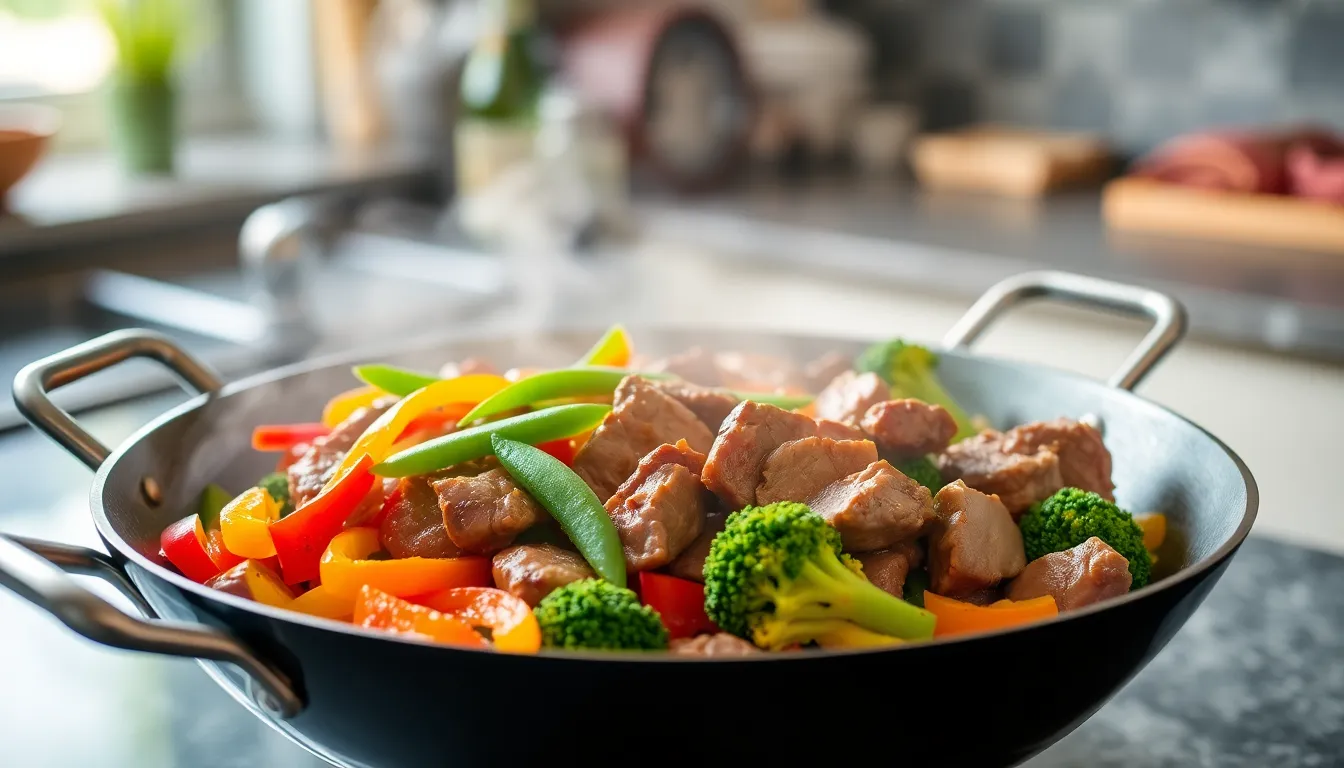
We love experimenting with different ingredients to make this classic dish your own. These variations allow you to customize the recipe based on dietary preferences and available ingredients.
Protein Substitutions
While beef remains the traditional choice, we can easily swap in other proteins for delicious results. Chicken breast or thighs work exceptionally well when cut into thin strips and cooked using the same technique. We slice the chicken similarly to beef and ensure it reaches an internal temperature of 165°F for food safety.
Pork slices offer another excellent alternative, providing a slightly different flavor profile while maintaining the dish’s authentic character. For our vegetarian friends, firm tofu or seitan serves as fantastic plant-based options. We recommend marinating these proteins for extra flavor absorption before cooking.
Shrimp can also transform this dish into a seafood delight, though we cook it for a shorter time to prevent overcooking. Each protein requires slight timing adjustments, but the core technique remains consistent.
Vegetable Additions
Beyond the signature broccoli, we can incorporate various vegetables to enhance texture and nutritional value. Bell peppers, snap peas, and baby corn complement the original recipe beautifully when stir-fried alongside the broccoli. These additions maintain the dish’s crisp texture while adding vibrant colors.
Mushrooms bring incredible umami depth to our stir-fry. We prefer shiitake or button mushrooms, sliced and added during the vegetable cooking stage. Carrots and bok choy contribute both crunch and visual appeal, while water chestnuts provide that distinctive crispy texture many of us crave.
| Vegetable Addition | Cooking Time | Texture Contribution |
|---|---|---|
| Bell peppers | 2-3 minutes | Crisp-tender |
| Snap peas | 1-2 minutes | Crunchy |
| Mushrooms | 3-4 minutes | Meaty |
| Water chestnuts | 1 minute | Crispy |
We add these vegetables based on their cooking times, starting with those requiring longer cooking periods. This approach ensures every component reaches the perfect doneness without compromising the dish’s signature quick cooking method.
Conclusion
We’ve shown you how to create restaurant-quality Chinese beef and broccoli right in your own kitchen. This 20-minute recipe delivers all the flavors you crave while giving you complete control over ingredients and nutrition.
The beauty of this dish lies in its simplicity and versatility. Whether you stick to our classic version or explore the variations we’ve shared you’ll have a satisfying meal that beats takeout every time.
With proper prep work and the right equipment you can master this stir-fry technique and apply it to countless other dishes. We’re confident this recipe will become a regular part of your weeknight dinner rotation.
Frequently Asked Questions
How long does it take to make Chinese Beef and Broccoli at home?
This homemade Chinese Beef and Broccoli recipe takes just 20 minutes from start to finish. The key is having all ingredients prepped beforehand, as stir-frying requires quick execution and constant attention. The beef marinates for 10 minutes while you prepare other components, making it perfect for busy weeknight dinners.
What cut of beef works best for this stir-fry recipe?
Flank steak is the recommended cut for this recipe due to its tender texture when sliced thinly against the grain. The beef is marinated in soy sauce, cornstarch, and sesame oil to enhance flavor and tenderness. For tougher cuts, you can use the velveting technique to achieve restaurant-quality results.
Can I make this dish ahead of time for meal prep?
Yes, you can prep components in advance by slicing the beef, cutting broccoli florets, and making the sauce. However, the dish is best served immediately after cooking to maintain its glossy finish and optimal texture. Cooked leftovers can be refrigerated for 3-5 days in an airtight container.
What equipment do I need to make authentic Chinese Beef and Broccoli?
You’ll need a wok or large skillet for high-heat stir-frying, mixing bowls for marinating, a sharp knife for slicing, measuring tools, and a spatula for stirring. Having all equipment ready before cooking is crucial since stir-frying requires constant attention and quick movements throughout the process.
How do I properly reheat leftover Chinese Beef and Broccoli?
Bring leftovers to room temperature, then reheat in a skillet or wok over medium heat with a splash of water or broth to loosen the sauce. Alternatively, use the microwave in short intervals while stirring. Avoid multiple reheating cycles to maintain quality and food safety.
Can I substitute other proteins or vegetables in this recipe?
Absolutely! You can substitute chicken, pork, tofu, seitan, or shrimp for the beef with slight timing adjustments. Additional vegetables like bell peppers, snap peas, mushrooms, carrots, and water chestnuts work well. Each vegetable has specific cooking times to ensure perfect doneness alongside the main ingredients.
Why shouldn’t I freeze leftover Chinese Beef and Broccoli?
Freezing is not recommended because broccoli becomes mushy when thawed and reheated, losing its crisp-tender texture that’s essential to the dish. The vegetable’s cellular structure breaks down during freezing, resulting in a less appealing texture that doesn’t match the restaurant-quality experience this recipe aims to deliver.
What makes the sauce glossy in Chinese Beef and Broccoli?
The glossy sauce comes from combining cornstarch with liquid ingredients like soy sauce, oyster sauce, and beef broth. When heated and stirred properly, the cornstarch creates a smooth, shiny coating that clings to the beef and broccoli, delivering that signature restaurant-style appearance and texture.

























